Bridge to the Moon
Just as Orion and the International Space Station are helping NASA learn how to go to Mars, the Gemini program defined and tested the skills NASA would need to go to the Moon in the 1960s and ‘70s. Gemini had four main goals: to test an astronaut's ability to fly long-duration missions (up to two weeks in space); to understand how spacecraft could rendezvous and dock in orbit around the Earth and the moon; to perfect re-entry and landing methods; and to further understand the effects of longer space flights on astronauts.

A New Ship
Similar in design to the Mercury capsule but much larger, the new Gemini spacecraft was designed to carry two astronauts into Earth orbit to test long-duration flight, rendezvous and docking and other techniques needed for journeys to the moon.
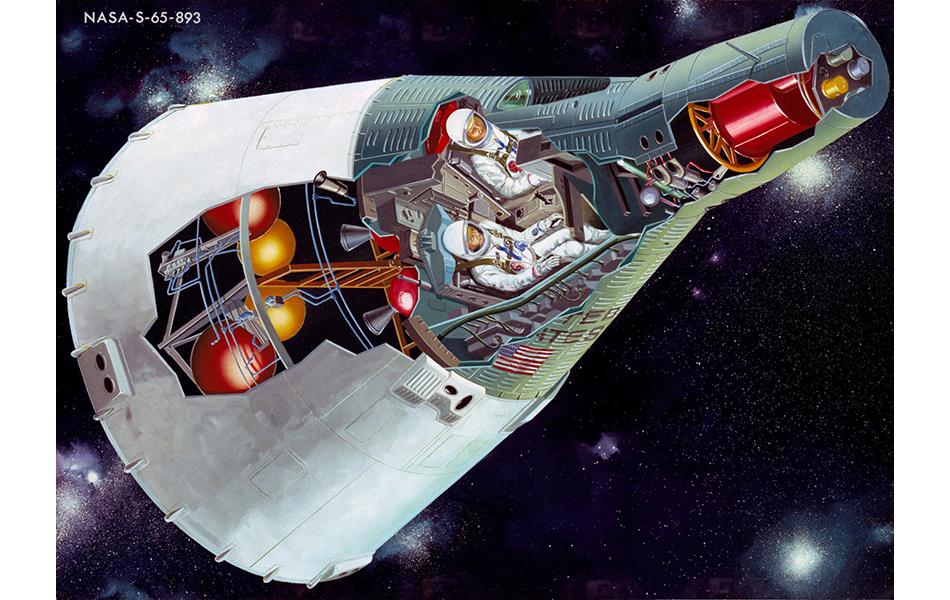
Powered by a Titan

To lift the heavier spacecraft, NASA turned to the powerful Titan II rocket. Here, the first Gemini-Titan ''stack'' lifts off from Cape Canaveral on April 8, 1964, on a successful unmanned test.
Standing at the Ready

A Gemini-Titan spacecraft sits on the launch pad in 1964, illuminated by pad lights and spotlights in the background.
Time Lapse Liftoff

A time exposure creates the illusion of multiple rocker arms as Gemini X launches.
Gemini-Titan 4 (GT-4) lift-off from Pad 19
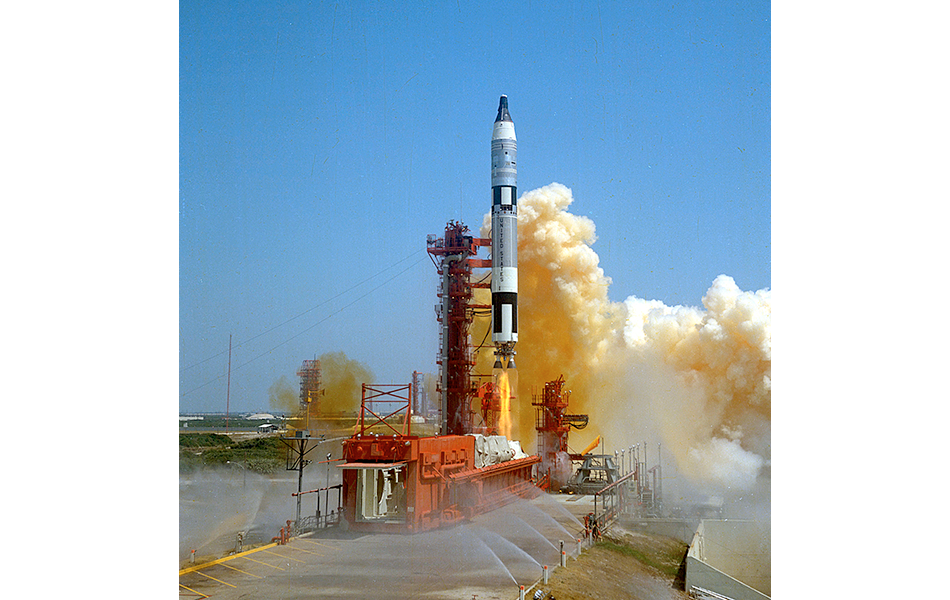
Gemini Crew Members
Gemini III "Molly Brown"
Mercury astronaut Gus Grissom, left, and John Young flew the first manned mission, Gemini III, which launched March 23, 1965. Grissom playfully dubbed the capsule ''Molly Brown'', referring to both a survivor of the sinking of the Titanic and his Mercury capsule, which filled with water and sank in the Atlantic after splashdown.
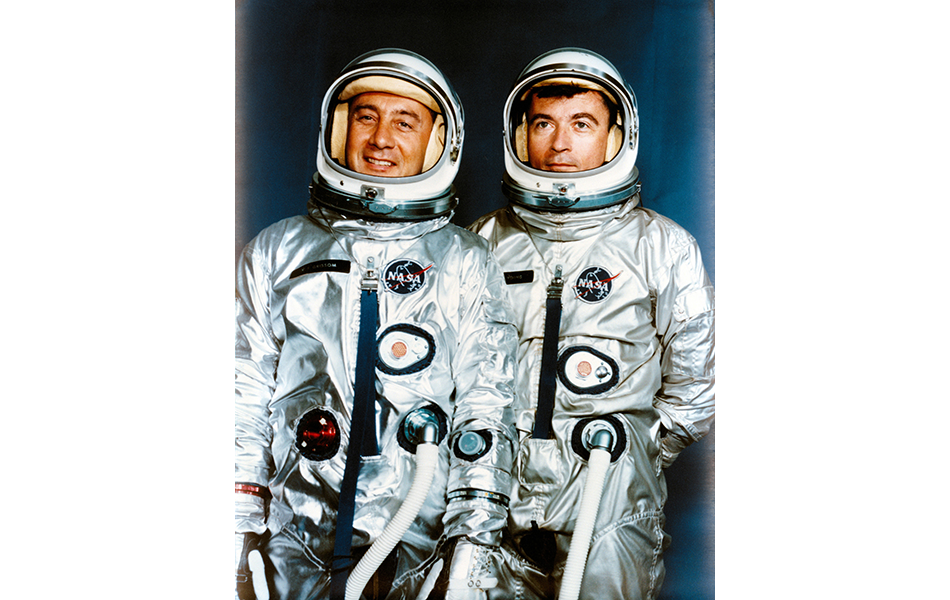
Gemini IV
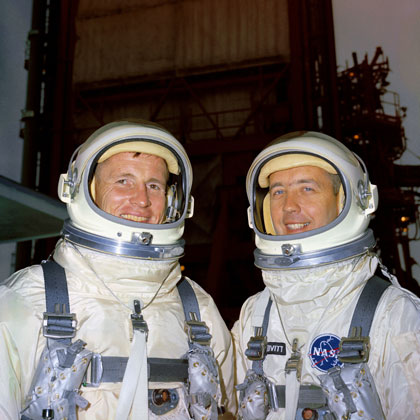
Astronauts Ed White, left, and Jim McDivitt rode Gemini 4 into space on June 3, 1965.
Gemini V
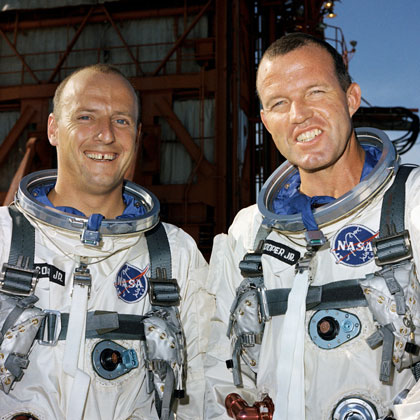
Future moonwalker Pete Conrad and Mercury pioneer Gordon Cooper teamed up for the Gemini V flight, which launched on Aug. 21, 1965.
Gemini VI-A

Tom Stafford, left, and Mercury astronaut Wally Schirra were the crew of Gemini 6. They were originally to launch in October 1965 and rendezvous with an unmanned Agena target vehicle. But the Agena didn't make it to orbit. NASA juggled the schedule, redesignated the mission ''Gemini VI-A' and set it to rendezvous with Gemini VII instead. After an initial launch attempt failed, Stafford and Schirra blasted off on Dec. 15, 1965.
Gemini VII

Astronauts Jim Lovell, left, and Frank Borman launched on Gemini VII on Dec. 4, 1965 and waited for Gemini VI-A to catch up. They eventually spent two weeks in orbit, the longest-duration flight to that time.
Gemini VIII
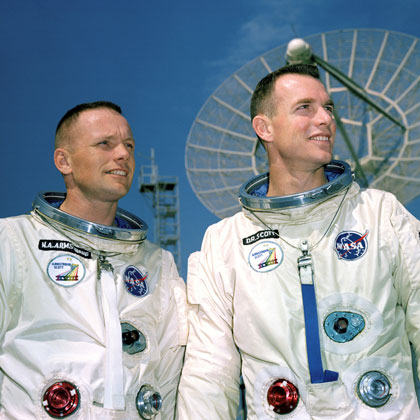
Before becoming the first human to set foot on the moon, astronaut Neil Armstrong joined another future moonwalker, Dave Scott, on Gemini VIII, launched on March 16, 1966.
Gemini IX-A
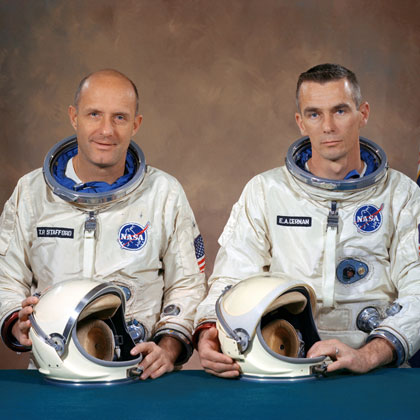
Tom Stafford, left, and Gene Cernan, both future Apollo commanders, teamed up on Gemini IX, launched on June 3, 1966. Originally set for a May launch, it was redesignated Gemini IX-A and rescheduled after another problem with an Agena target vehicle. Stafford and Cernan would instead dock with an "augmented target docking adapter."
Gemini X
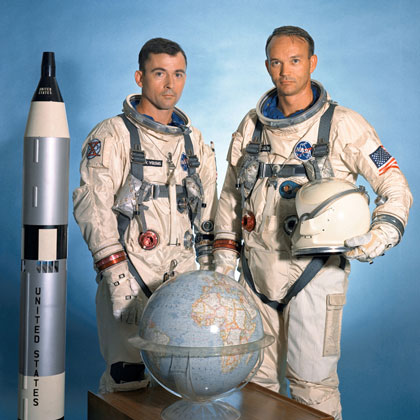
Gemini X astronauts John Young and Michael Collins pose next to a model of the Gemini-Titan spacecraft. They launched on July 18, 1966.
Gemini XI
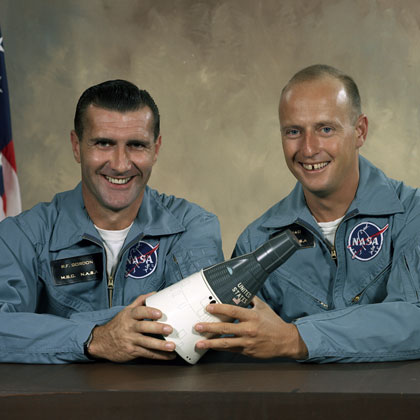
Astronauts Dick Gordon, left and Pete Conrad launched on Gemini XI on Sept. 12, 1966. The pair would later travel to the moon together during the Apollo 12 mission in November 1969
Gemini XII
Gemini XII astronauts "Buzz" Aldrin, left, and Jim Lovell pose with a mockup of their spacecraft. They launched on Nov. 11, 1966, on the final Gemini mission.
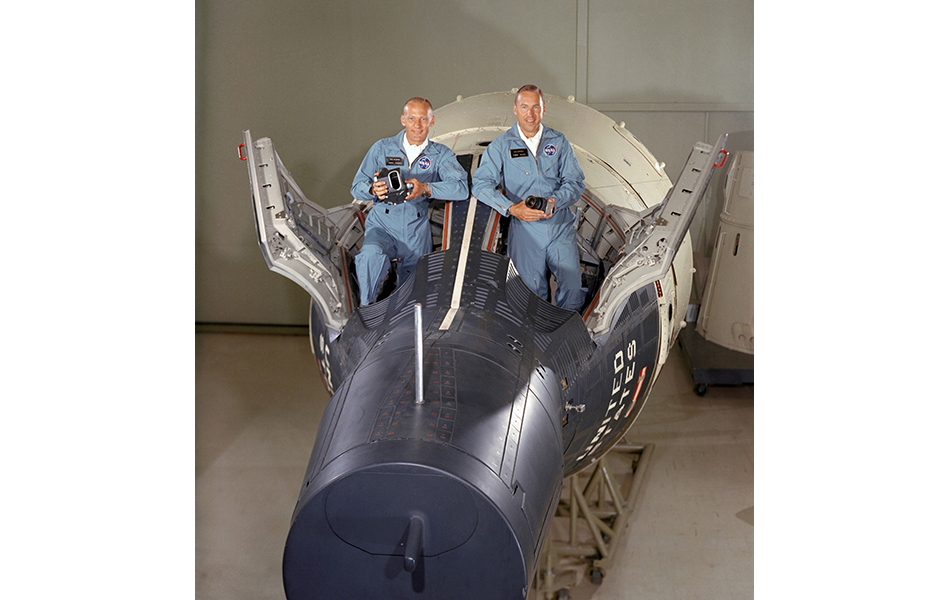
"Suit Up!": Americans Walk in Space
Ed White
On June 3, 1965, Gemini IV astronaut Edward H. White II became the first American to step outside his spacecraft and let go, effectively setting himself adrift in the zero gravity of space. For 23 minutes White floated and maneuvered himself around the spacecraft, logging 6,500 miles during his orbital stroll. White was attached to the spacecraft by a 25-foot umbilical line. In his right hand White carried a Hand Held Self Maneuvering Unit (HHSMU), which he used to move about the weightless environment of space. The visor of his helmet was gold-plated to protect him from the unfiltered rays of the sun.
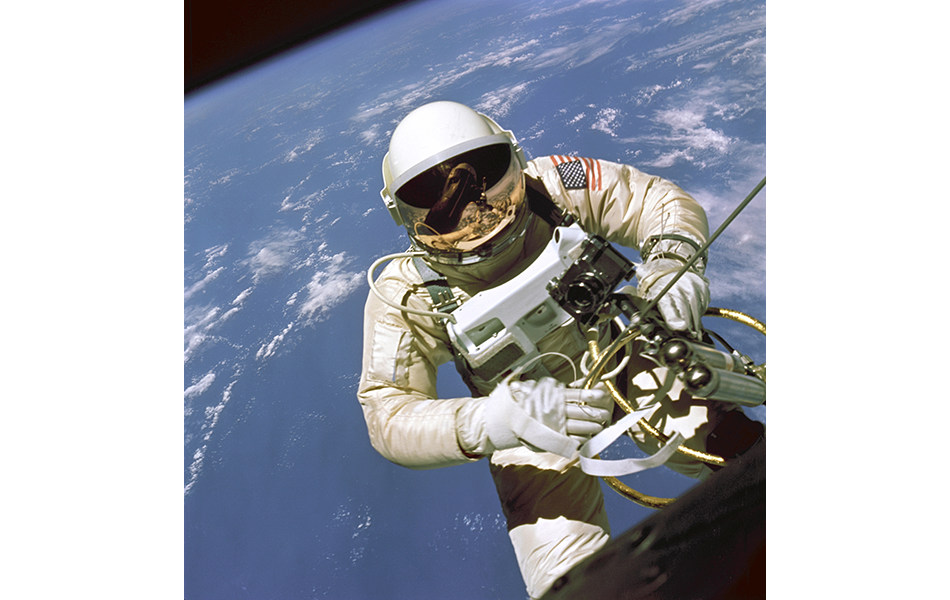
Spacewalk
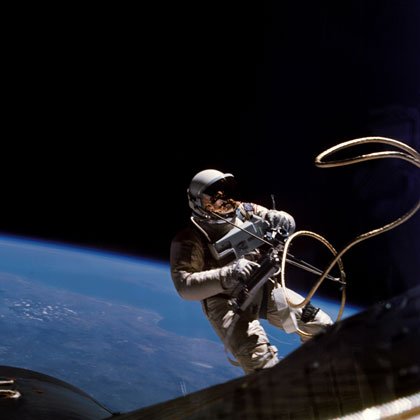
White initially used the gas-powered maneuvering unit to move around, but after the first three minutes the fuel ran out. White maneuvered by twisting his body and pulling on the umbilical cord.
White's 'Saddest Moment'
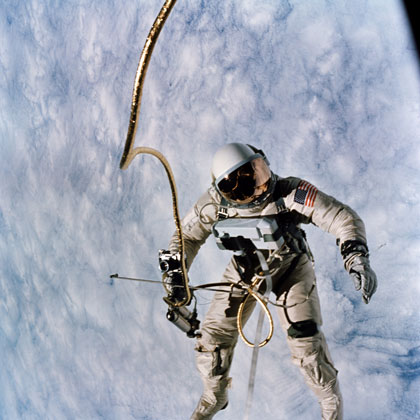
The 23-minute spacewalk did not last nearly long enough for White. He later said the spacewalk was the most comfortable part of the mission, and that the order to end it was the "saddest moment" of his life.
Cernan Walks in Space
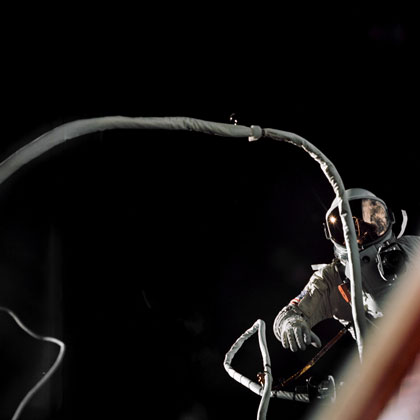
Gemini IX also featured a two-hour spacewalk by Gene Cernan, the second in NASA history.
Saddle Up
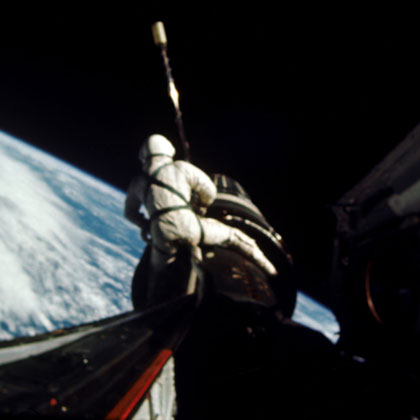
A spacewalking Dick Gordon makes his way back to the Gemini XI capsule after straddling the Agena target vehicle to attach a tether. The crew had used the Agena's engine to set a new altitude record of 850 miles.
Aldrin's Adventure
Aldrin is photographed during his record setting 5-hour, 30-minute spacewalk. Aldrin was the first astronaut to practice his spacewalking tasks underwater in a swimming pool, resulting in Gemini's most successful spacewalk. Later he would join Neil Armstrong on the first lunar landing in 1969.
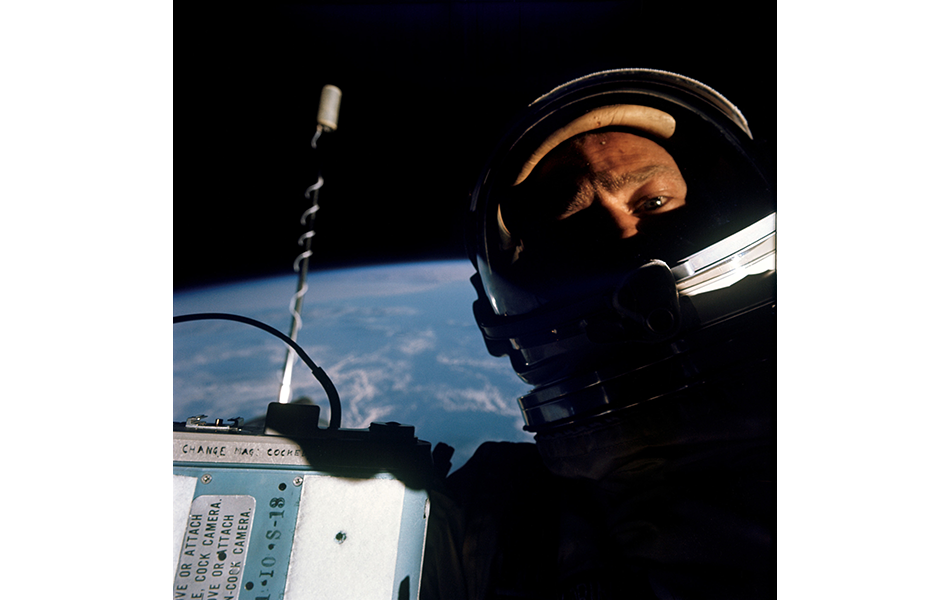
Rendezvous and Docking in Space
Gemini VIII made the first successful docking in space, linking up with the Agena Target Vehicle seen below. Docking spacecraft was an essential element of NASA's plan to go to the moon. Unfortunately, during the docking maneuvers, one of the Gemini capsule's thrusters short-circuited and fired continuously, sending the docked spacecraft into a spin. The crew undocked the capsule and used their re-entry thrusters to regain control, but safety rules about using the reentry thrusters forced them into an early landing.
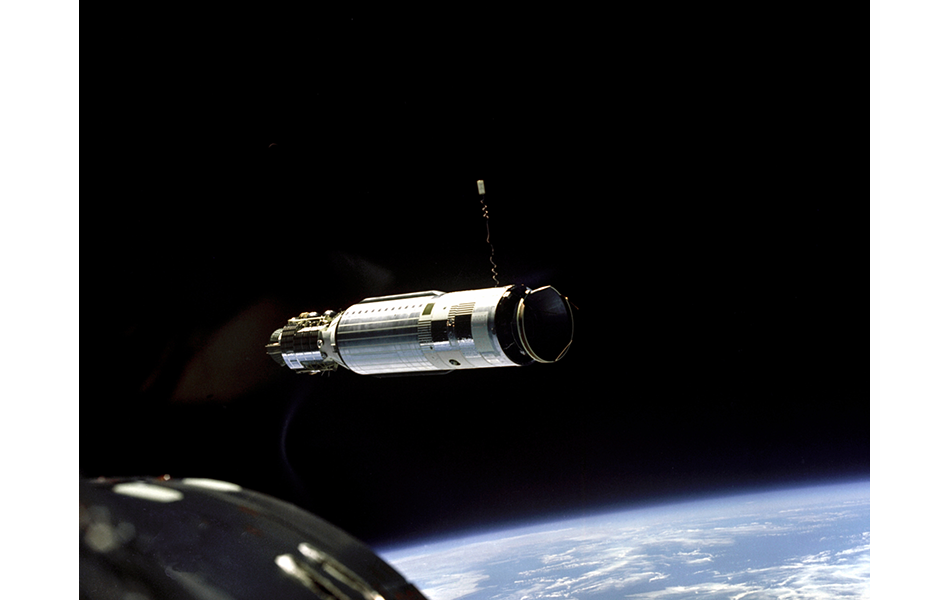
Up Close and Personal
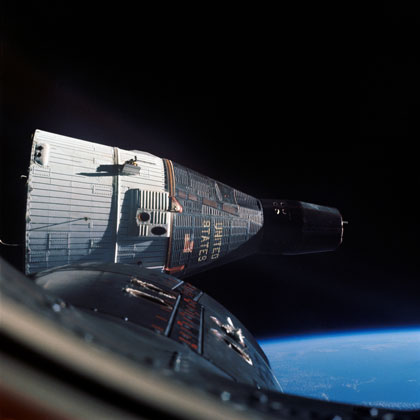
Gemini VII is seen from the hatch window of Gemini VI. It was the first time NASA had two manned spacecraft in orbit at the same time.
Six Plus Seven = Rendezvous
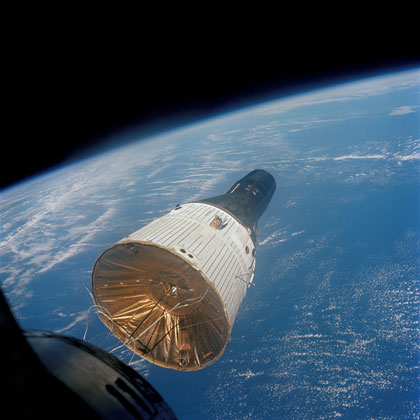
Another stunning view of Lovell and Borman's Gemini VII capsule from Gemini VI-A. The two spacecraft were about 30 feet apart when this photo was made.
The "Angry Alligator"
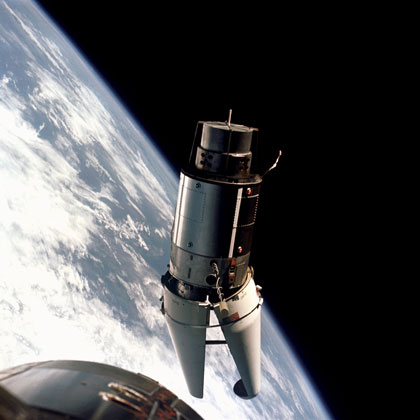
Gemini IX-A's docking didn't go as planned, because a protective shroud on the docking adapter failed to fully separate. Stafford dubbed the adapter an "angry alligator," but the crew managed to perform several other rendezvous maneuvers.
Agena's Engine
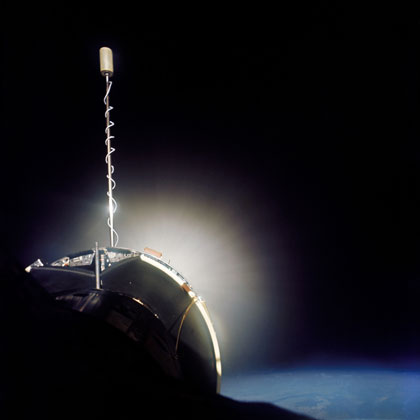
Young and Collins successfully docked with an Agena target vehicle and fired its engine to climb to a higher orbit. Collins also made NASA's third spacewalk.
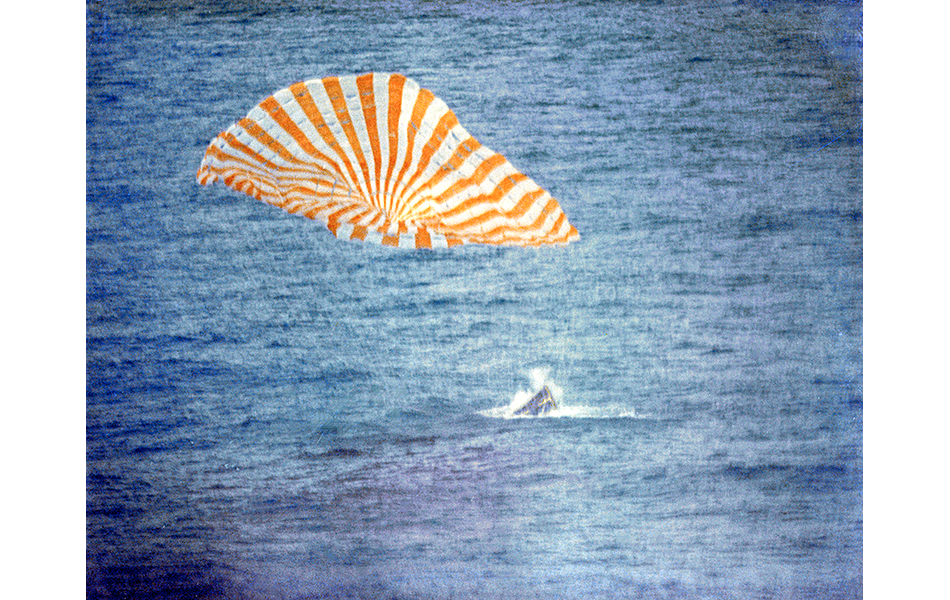
The program ended with Gemini XII's splashdown on Nov. 15, 1966, and NASA moved on to Apollo. On July 20, 1969, NASA achieved President John F. Kennedy's goal of landing a man on the moon before the end of the decade.